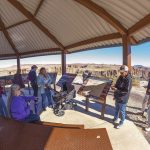
Reporter’s Notebook | Our backyard, The Door
By Nicholas House
Navajo Times
I didn’t step into The Door Christian Fellowship Church myself, but I didn’t need to. The footage speaks loud enough. Marketed as a revival, what unfolded on stage wasn’t worship. It was war, waged through theater, cloaked in salvation, and aimed squarely at Navajo identity.
The red lights. The shaking. The performance. They didn’t even bother hiding the metaphor. A “medicine man” character – his hair long wrapped with a headband; his movement deliberate – was positioned as the enemy of Christ. A demon. I watched the videos of him writhe and getting “saved” in the end, delivered from his “paganism.”
I’m sure the room was Native. Many were Diné. Some were teenagers. Some were children. All impressionable.
There was silence in my throat. Not because I was shocked, it takes a lot to shock a Navajo who’s lived between worlds, but because I knew what I was watching: indoctrination disguised as theatre. A forced reckoning dressed up in Sunday best.
A familiar violence.
This wasn’t new. This was old. Just dressed differently.
I thought about the grandmothers who had their hair cut in boarding schools. I thought about how my own people (my friends, my cousins) were made to feel ashamed for praying with corn pollen and wearing turquoise and silver. I thought about how trauma doesn’t just live in bones. It lives in performance. It lives in manipulation.
What they did on that stage wasn’t just distasteful. It was a desecration of belief. And let’s be clear: it was calculated. This wasn’t an accident. They didn’t “happen” to parody Navajo spirituality. They choreographed it. They cast it. They rehearsed it.
They turned our way of life into a villain’s arc.
A city of crossroads.
Gallup has always been a strange, spiritual battleground. It’s where pawn shops outnumber grocery stores, where prayer comes in all accents and all motives. It’s where people get clean or get lost. It’s a border town with blurred borders, between hope and hurt, between culture and conversion.
And that’s the heartbreak: some of the people in that audience weren’t outsiders. They were Diné.
That’s where this gets complicated. Because I don’t hate those who sat quietly. I don’t even hate those who clapped. I see them. I see their history. I see the starvation they inherited, from Long Walk survivors, from a society that erased the scaffolding that once held them up. They’re not demons or traitors. They’re hungry.
But hunger does not excuse harm.
The unseen harm.
You can say it’s “just a skit.” But in Navajo worldview, words have power. Representations have power. When you make our ceremonies into something ugly, you aren’t just being offensive, you’re rearranging the cosmos. You’re shifting children’s minds. You’re telling them that the way their grandparents prayed was evil. Christianity is a young concept still to North America, compared to the history of the land. 532 years young. Moreover, there more federally recognized tribes to compare that number, 574. Navajo Nation is only one.
This is what intergenerational trauma looks like when it plays out under red stage lights.
And yet I’ve heard no apology. No accountability. Only silence from The Door. The Navajo Times received no response about its action.
What now?
We, the people who still believe in hózhǫ, must decide what our response looks like. Do we protest? Do we meet with them? Do we turn our backs? I don’t know. But I know we must respond.
Because this is a test, not just of our patience, but of our strength. Can we call this out without replicating the same spiritual violence? Can we correct without condemning? Can we walk in beauty and still stand our ground?
I believe we can. I believe in k’é, in relationships, in reminders, in responsibility. But I also believe in fire. And this moment? This moment demands heat. Over 400,000 Diné, weather they know or not, (again) have now been categorized as a people destined for the White man’s Hell and our grandmothers’ prayers as sin.
We cannot let this slide. Not in 2025. Not in Gallup. Not while our youth are still finding their way back to the songs that once carried them.
I drove by that church disgruntled, yes. But more than that, I was committed. To reminding every Diné kid that our ways are not dark. Our medicine is not evil. Our power is not up for parody.
Not anymore.
To those Diné who were witness or were a part of the skit: how did that bring one closer to God? Did that empower or heal? Matthew 7:5 (King James Version) “Thou hypocrite, first cast out the beam out of thine own eye; and then shalt thou see clearly to cast out the mote out of thy brother’s eye.” Isaiah 5:20 (New International Version) “Woe to those who call evil good and good evil, who put darkness for light and light for darkness ….”








 Highway 264,
Highway 264, I-40, WB @ Winslow
I-40, WB @ Winslow